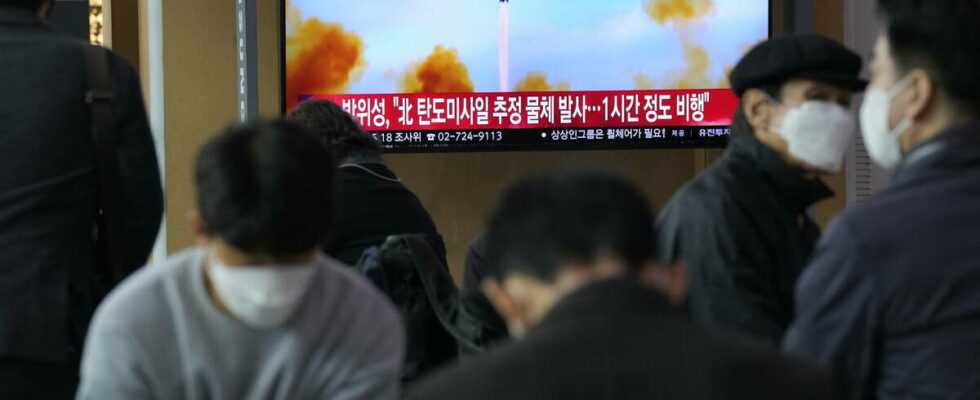The warhead was damaged in the exclusive economic zone of Japan, the Archipelago qualifying this shooting as a “serious threat” to its safety. Seoul retaliated with land, sea and air missile fire.
From the unidentified projectile to the intercontinental ballistic missile. This Thursday, North Korea fired a new missile, this time towards Japan. A shot that adds to a long series of launches from Pyongyang since the start of the year. “Our analyzes indicate that the ballistic missile flew for 71 minutes and fell at approximately 3:44 p.m. (0644 GMT) in the exclusive economic zone in the Sea of Japan, approximately 150 km west of the peninsula of ‘Ōshima’, the northern island of Hokkaido, said the number two of the Ministry of Defense Makoto Oniki, also specifying that it could be an intercontinental ballistic missile (ICBM). Information confirmed by Seoul. “North Korea fired an unidentified projectile towards the east”, had for their part warned the South Korean Joint Chiefs of Staff in a press release. A few hours later, land, sea and air missiles were fired by South Korea in response.
According to the Japanese Minister of Defense, no reports of damage to ships or aircraft have been reported, but he describes this shooting as “serious threatfor the safety of Japan. “As the world faces Russia’s invasion of Ukraine, North Korea continues its firing which unilaterally escalates provocations against the international community, which is absolutely unforgivable”, said Makoto Oniki. Japanese Prime Minister Fumio Kishida denouncedan outrageous act that cannot be forgiven“.
“Insolent violation” of international resolutions
In a statement, South Korean President Moon Jae-in confirmed that the projectile launched Thursday by Pyongyang towards the Sea of Japan was indeed an ICBM and therefore “a break in the suspension of intercontinental ballistic missile launches promised by President Kim Jong Un to the international community”. “It poses a serious threat to the Korean peninsula, to the region and to the international community.“, he added. Pyongyang has been supposed to abide by a self-imposed moratorium on ICBM and nuclear weapons testing since leader Kim Jong Un embarked on a series of high-profile diplomatic meetings with Donald Trump in 2018.
United States “strongly condemn” the firing of an intercontinental ballistic missile by North Korea and will take “all necessary measures to ensure the security of the United States, South Korea and Japan”, according to a statement from the White House on Thursday. This North Korean shotis an insolent violation of multiple United Nations Security Council resolutions and unnecessarily increases tensions. in the region, reacted the spokesperson for the American executive Jen Psaki, in this text published when President Joe Biden meets the allies of the United States in Brussels.
North Korea fired a ballistic missile last week, but the test ended in failure, according to the South Korean military. “Our military maintains a firm posture of defense readiness while closely monitoring related developments,” responded the South Korean Joint Chiefs of Staff. According to analysts, last week’s failed launch was related to the launch of a Hwasong-17 missile, nicknamed the “monster missile, an ICBM that has never been launched. In contrast, the missile fired Thursday morning flew at high altitude. Something to worry observers. “Since the ballistic missile this time flew at an altitude of more than 6,000 km, which was much higher than the ICBM Hwasong-15 (missile) which was launched in November 2017, it is believed that the one today is a new ICBM”said the Japanese authorities on Thursday morning.
What are we talking about? A launcher capable of carrying military loads to another continent. These missiles designed after the Second World War are generally designed to deliver one or more nuclear warheads. The very first intercontinental ballistic missile was the R-7 Semiorka, developed by the USSR in 1957. Once launched, the intercontinental ballistic missile experiences a boost phase lasting 4 minutes and flies at an altitude of between 150 and 200 kilometers. Then comes the intermediate phase: for a target located 12,000 kilometers away, count 25 minutes of flight. During its phase of re-entry into the atmosphere, the missile can release a few warheads with their own trajectory, decoys and explosive charges.
All permanent members of the United Nations (UN) Security Council have operational systems to launch ICBMs and possess nuclear-powered ballistic missile submarines, and Russia, the United States and China have land bases for launching intercontinental ballistic missiles. In addition, China and Russia have mobile ground systems.
